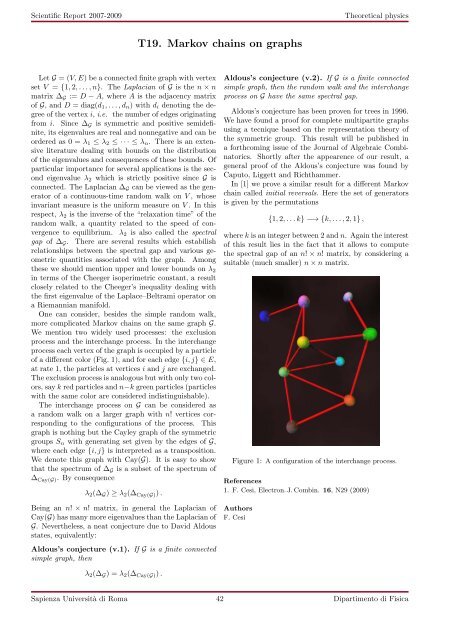download report - Sapienza
download report - Sapienza
download report - Sapienza
You also want an ePaper? Increase the reach of your titles
YUMPU automatically turns print PDFs into web optimized ePapers that Google loves.
Scientific Report 2007-2009<br />
Theoretical physics<br />
T19. Markov chains on graphs<br />
Let G = (V, E) be a connected finite graph with vertex<br />
set V = {1, 2, . . . , n}. The Laplacian of G is the n × n<br />
matrix ∆ G := D − A, where A is the adjacency matrix<br />
of G, and D = diag(d 1 , . . . , d n ) with d i denoting the degree<br />
of the vertex i, i.e. the number of edges originating<br />
from i. Since ∆ G is symmetric and positive semidefinite,<br />
its eigenvalues are real and nonnegative and can be<br />
ordered as 0 = λ 1 ≤ λ 2 ≤ · · · ≤ λ n . There is an extensive<br />
literature dealing with bounds on the distribution<br />
of the eigenvalues and consequences of these bounds. Of<br />
particular importance for several applications is the second<br />
eigenvalue λ 2 which is strictly positive since G is<br />
connected. The Laplacian ∆ G can be viewed as the generator<br />
of a continuous-time random walk on V , whose<br />
invariant measure is the uniform measure on V . In this<br />
respect, λ 2 is the inverse of the “relaxation time” of the<br />
random walk, a quantity related to the speed of convergence<br />
to equilibrium. λ 2 is also called the spectral<br />
gap of ∆ G . There are several results which estabilish<br />
relationships between the spectral gap and various geometric<br />
quantities associated with the graph. Among<br />
these we should mention upper and lower bounds on λ 2<br />
in terms of the Cheeger isoperimetric constant, a result<br />
closely related to the Cheeger’s inequality dealing with<br />
the first eigenvalue of the Laplace–Beltrami operator on<br />
a Riemannian manifold.<br />
One can consider, besides the simple random walk,<br />
more complicated Markov chains on the same graph G.<br />
We mention two widely used processes: the exclusion<br />
process and the interchange process. In the interchange<br />
process each vertex of the graph is occupied by a particle<br />
of a different color (Fig. 1), and for each edge {i, j} ∈ E,<br />
at rate 1, the particles at vertices i and j are exchanged.<br />
The exclusion process is analogous but with only two colors,<br />
say k red particles and n−k green particles (particles<br />
with the same color are considered indistinguishable).<br />
The interchange process on G can be considered as<br />
a random walk on a larger graph with n! vertices corresponding<br />
to the configurations of the process. This<br />
graph is nothing but the Cayley graph of the symmetric<br />
groups S n with generating set given by the edges of G,<br />
where each edge {i, j} is interpreted as a transposition.<br />
We denote this graph with Cay(G). It is easy to show<br />
that the spectrum of ∆ G is a subset of the spectrum of<br />
∆ Cay(G) . By consequence<br />
λ 2 (∆ G ) ≥ λ 2 (∆ Cay(G) ) .<br />
Being an n! × n! matrix, in general the Laplacian of<br />
Cay(G) has many more eigenvalues than the Laplacian of<br />
G. Nevertheless, a neat conjecture due to David Aldous<br />
states, equivalently:<br />
Aldous’s conjecture (v.2). If G is a finite connected<br />
simple graph, then the random walk and the interchange<br />
process on G have the same spectral gap.<br />
Aldous’s conjecture has been proven for trees in 1996.<br />
We have found a proof for complete multipartite graphs<br />
using a tecnique based on the representation theory of<br />
the symmetric group. This result will be published in<br />
a forthcoming issue of the Journal of Algebraic Combinatorics.<br />
Shortly after the appearence of our result, a<br />
general proof of the Aldous’s conjecture was found by<br />
Caputo, Liggett and Richthammer.<br />
In [1] we prove a similar result for a different Markov<br />
chain called initial reversals. Here the set of generators<br />
is given by the permutations<br />
{1, 2, . . . k} −→ {k, . . . , 2, 1} ,<br />
where k is an integer between 2 and n. Again the interest<br />
of this result lies in the fact that it allows to compute<br />
the spectral gap of an n! × n! matrix, by considering a<br />
suitable (much smaller) n × n matrix.<br />
Figure 1: A configuration of the interchange process.<br />
References<br />
1. F. Cesi, Electron. J. Combin. 16, N29 (2009)<br />
Authors<br />
F. Cesi<br />
Aldous’s conjecture (v.1). If G is a finite connected<br />
simple graph, then<br />
λ 2 (∆ G ) = λ 2 (∆ Cay(G) ) .<br />
<strong>Sapienza</strong> Università di Roma 42 Dipartimento di Fisica

















